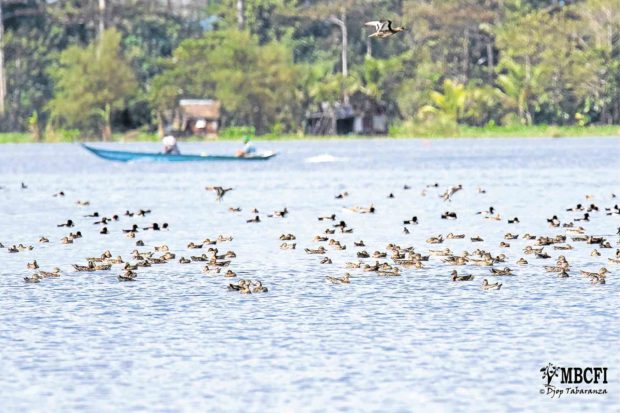
Migratory ducks feed undisturbed at Naujan Lake in Oriental Mindoro province. —MINDORO BIODIVERSITY CONSERVATION FOUNDATION INC.
CITY OF CALAPAN — While the number of migratory birds seen at the Naujan Lake National Park (NLNP) in Oriental Mindoro province was down this year, conservationists have noted the presence of two new species of ducks in the lake.
Results of the Asian Waterbird Census (AWC) held on
Jan. 18 showed 5,523 birds at the 8,125-hectare NLNP, which were fewer than the 6,907 counted in 2017.
The census, conducted in time for the World Wetlands Day on Feb. 2, was participated in by the Department of Environment and Natural Resources and the Mindoro Biodiversity Conservation Foundation Inc. (MBCFI).
Tufted ducks
“I am saddened with the low count this year for the AWC, but not actually discouraged as there are new species recorded for Naujan Lake. We also observed large number of ducks in December,” said Ricardo Natividad, NLNP protected area superintendent.
The five groups composing the AWC team spotted garganeys (Spatula querquedula) and Eurasian wigeons (Anas penelope) among tufted ducks at Naujan Lake.
“We were excited, as we saw a lot of small pale brown ducks and a few red-headed ducks amid the dark tufted ducks that we usually see. This is possibly the first record of garganeys and Eurasian wigeons at Naujan Lake and in Mindoro,” said
Geoff Tabaranza, MBCFI research program manager.
The birds counted during the census comprised 33 species. The biggest group was composed of tufted ducks (Aythya fuligula) at 2,692 individuals, followed by garganeys at 832 individuals and whiskered terns (Chlidonias hybrida) at 806.
Protected area
Tabaranza said the decrease on the number of birds was possibly due to the high mobility of the ducks and an incomplete AWC survey coverage of the lake.
He recommended a wider coverage of the census area and the deployment of a bigger team in the next census.
Tabaranza said the conduct of regular biodiversity monitoring system, finalization of a protected area management plan, and the declaration of NLNP as protected area under the National Integrated Protected Areas System (Nipas) Act should be done to protect the lake and park.
Conservationists have been encouraging residents around the lake to practice sustainable agriculture and proper waste management to reduce pollution from agricultural and domestic wastes.
“We are still very hopeful that with these initiatives, the habitats in Naujan Lake will improve and the number of migratory birds will increase in the coming years,” Natividad said. —Madonna T. Virola